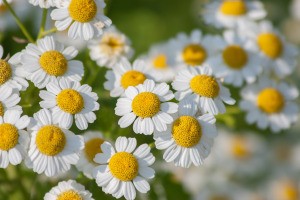
| Botanical Name: |
| Chrysanthemum parthenium / Tanacetum parthenium |
| Common names: |
| also sold as Matricaria eximia |
| Description: |
| Feverfew is a lovely perennial herb that has white, daisy-like flowers with yellow centers and soft, light green serrated leaves. Plants grow from 9 to 24 inches high and produce single or double flowers for most of the summer and early fall. Advertisement |
| Life Cycle: |
| perennial or tender annual |
| Exposure: |
| full sun to partial shade |
| Cultivation: |
| Feverfew will grow in almost any soil. It should be started from seeds sown directly in the ground in spring or from cuttings taken in the summer. Plans will self-sow and flowers should be removed as needed to focus energy on leaf production. Feverfew is considered a short-lived perennial, so plant in succession to maintain a supply of new plants. Let a few seed heads remain in the garden in early fall and you may get new seedlings the following spring. Feverfew also grows well in containers. |
| Propagation: |
| seeds, cuttings or division |
| Parts Used: |
| leaves |
| Harvesting and Storage: |
| cut fresh leaves for use as needed or dry and store in an airtight container. |
| Medicinal Uses: |
| headache tonic; relief from insect bites; calms nerves; soothes coughs and aids in breathing |
| Culinary Uses |
| none |
| Other Uses: |
| skin care, moth repellant, and plantings for walkways, edgings, beds and borders. |
Check out these photos.
Feverfew is a type of chrysanthemum and spreads like wildfire in our garden and we have to weed some of it out, but it is a very pretty plant. It is also medicinal, containing salicylic acid (the stuff aspirin is made of) and therefore said to be good for headaches.